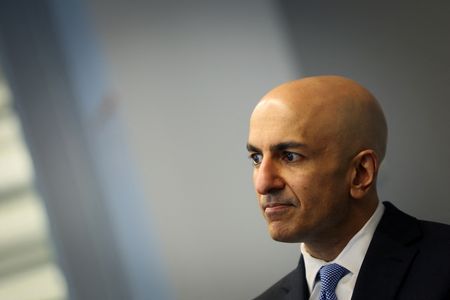By Howard Schneider
WASHINGTON (Reuters) -Inflation lodged above the U.S. Federal Reserve’s 2% target could leave policymakers saddled with the difficult choice in coming months of how much risk to take with economic growth and the job market for what may only be modest further improvements in the pace of price increases.
Inflation has been largely stalled for the first three months of the year at a rate, roughly 2.7%, that policymakers regard as still too far above their target to declare the job finished, but also so close to it they’ve been reluctant to yet say that further rate increases may be likely.
If inflation simply flatlines from here, central bank chief Jerome Powell said at a press conference following last week’s meeting, the Fed could simply wait it out, still confident that the current policy rate of interest is high enough to coax inflation lower.
But Minneapolis Fed President Neel Kashkari raised another possibility on Tuesday in a new essay in which he said recent data – from the strength of the housing market to the ongoing strength of demand – suggested that Fed policy may not be as tight as officials suspect, and that inflation may instead be “settling to around a 3% level.”
Kashkari’s essay highlights the potential dilemma policymakers face if inflation simply sticks where it is. In other comments on Tuesday Kashkari said he expects the Fed to need to hold rates steady for an “extended period.”
Powell and other officials say they will be looking at the “totality” of economic data in making decisions – assessing inflation’s stickiness, for example, in the context of what is happening in the job market and within the economy as a whole, whether public expectations around inflation remain stable or start to shift higher, and whether policymakers feel their own credibility is on the line.
The U.S. central bank at its meeting last week kept the benchmark policy rate steady in a range of 5.25% to 5.5%, where it has been since July, with officials generally resetting expectations for a later start and less overall policy easing this year, but also downplaying the likelihood of further rate increases.
Updating his policy view in a Monday conversation with reporters, Richmond Fed President Thomas Barkin said that his response to a continued lack of progress on inflation might, for example, hinge on whether overall demand in the economy remained strong or seemed to be weakening.
“If demand is vibrant, robust, and the numbers aren’t moving, that’s very different than if demand is weakening or fragile,” he said. “Rates are supposed to influence demand which is supposed to influence inflation. If they are not influencing demand or inflation that’s very different then if they are.”
Kashkari’s essay suggested the Fed’s current benchmark rate simply may not be doing enough – at least at this point – and questioned whether policymakers have underestimated the “neutral” rate of interest and therefore expect current policy to have more impact than it will.
Residential investment is rebounding, he noted, despite relatively high mortgage interest rates. Like other Fed officials he said he feels weak first-quarter growth in gross domestic product masked strong underlying demand. April job growth fell from the higher numbers seen during the recovery from the pandemic, but remained healthy with an unemployment rate still under 4% as it has been for more than two years.
A wrong understanding of how tight policy really is “could explain the constellation of data we are observing,” Kashkari wrote. “The question we now face is whether the disinflationary process is in fact still underway, merely taking longer than expected, or if inflation is instead settling to around a 3% level, suggesting that the (Federal Open Market Committee) has more work to do to achieve our dual mandate goals.”
What that “work” entails will reopen an issue policymakers had hoped they’d settled – over how much economic growth may need to be suppressed in order to achieve the 2% goal, whether higher interest rates will be needed to do it, and whether the tradeoffs are worth it to reduce headline inflation a few tenths of a percentage point.
Fed officials across the board have been adamant they will return inflation to 2%.
But they’ve no particular timetable.
The most recent Fed economic projections issued in March see the target reached by the end of 2026, though that could change when new projections are issued at the Fed’s June 11-12 meeting.
Those projections will include new guidance on the path of interest rates. While officials downplay the idea rates will need to rise again, a continued stall in inflation at its current level does pose a “challenge” Kashkari said.
“With inflation in the most recent quarter moving sideways, it raises questions about how restrictive policy really is,” Kashkari wrote.
(Reporting by Howard Schneider; Editing by Andrea Ricci)




